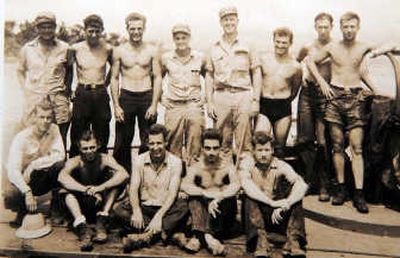CdA resident recounts PT boat combat

At age 85, Rees Bybee plays three or four rounds of nine-hole golf a week on Coeur d’Alene’s municipal course. No motorized or pull cart for him; he still carries his clubs.
That’s remarkable enough, but it’s not the Coeur d’Alene resident’s only claim to fame: He was one of those sailors who manned one of the 800 motor torpedo boats – popularly known as PT boats – that patrolled the waters of the Atlantic, Pacific, Mediterranean, Aleutians, Panama, the Philippines and the English Channel during World War II.
John Kennedy skippered one of them, the famous PT 109. And a book and 1945 movie, “They Were Expendable” starring John Wayne and Robert Montgomery, highlighted the exploits of men like Bybee who went in harm’s way in those 80-foot 45-knot mahogany boats.
The book and movie title refer to the fact that, during that war, President Franklin D. Roosevelt and England’s Prime Minister Winston Churchill made a strategic decision to concentrate most of the Allies’ efforts on our enemies in Europe – Germany and Italy – rather than on the Japanese.
So Rees and his fellow servicemen stationed in the Pacific fought a largely unsupported war. But they fought it well.
By early August 1945 Allied sailors, soldiers, Marines and airmen had beaten the Japanese back to their own shores, only three months after Germany had surrendered. The atomic bombs on Hiroshima and Nagasaki ended that worst of all world conflicts as Bybee and his fellow warriors were poised to invade the Japanese home islands.
Bybee blesses the memory of President Harry Truman, who decided to drop those bombs. Late in the war he had been detailed to the Office of Strategic Services – predecessor to the Central Intelligence Agency – as a boat driver.
Had the invasion taken place, his role would have been to pilot an 85-foot explosive-laden boat into a Japanese river channel, then abandon the vessel. An Air Corps officer in an orbiting airplane would have guided it by means of on-board televisions and electronics to blow up a Japanese defense emplacement.
Japan’s surrender canceled that mission – one of the few to which Bybee was summoned that was called off.
A Sacramento native and Jonathan Winters look-alike, Bybee was 20 and had 2 1/2 years of college when he enlisted in the Navy in 1942. During boot camp in San Diego he volunteered for motor torpedo boats and was sent to that tiny command’s only school, at Melville, R.I.
There, he was trained as a torpedo man, but learned also the jobs of the other 11 enlisted men that were to be assigned to his boat. At the Brooklyn Navy Yard, the dozen trainees were joined by two officers, then the crew was mustered into the 12-boat MTB Squadron 21 and sent to war.
In 1943, the men and their boats were shipped on tankers, their boats cinched to the top decks of the larger vessels with large turnbuckles so that, in the event the tankers were sunk, the PT boats could be loosed to float free. The PT crewmen bunked in their boats.
Squadron 21 was stationed in the Southwest Pacific, with eventual duty stations in New Guinea, New Britain and the Admiralty Islands. They had no contact with the future president and his squadron stationed thousands of miles away in the South Pacific.
Bybee recounts 23 missions when his boat, PT 326, came under fire. They were night missions for, at that time in the war, the Allied forces had not yet gained air superiority.
“And we didn’t get hazardous-duty pay for any of them,” he says. “The only ones eligible for that were aircrew and submariners.”
His boat was credited with sinking 13 Japanese motorized and armored barges the enemy was using to supply its troops. Its gunners were also credited with downing two enemy aircraft which had dropped bombs on them, just missing their boat fore and aft.
The most hazardous missions, Bybee says, were those when his boat was ordered to penetrate Japanese anchorages, fire flares from a deck-mounted mortar, and then count the number and kind of vessels at anchor.
Several times, PT 326 also delivered and picked up Australian coast watchers 150 miles behind enemy lines.
Despite the fact that his boat was armed with torpedoes, none was fired during his many missions. Their kills were all accomplished by the boat’s 50-caliber machine guns and 20 mm and 40 mm cannons.
During his 18 months of combat, Squadron 21 lost only one boat, and PT 326 came through unscathed, without even a bullet hole in her hull.
His squadron was one of only two to receive a Presidential Unit Citation for its actions.
Discharged in October 1945, Bybee returned to civilian life in California and, over the years, worked in the insurance industry, ran a public swimming pool, was a purchasing agent for a distilling company and a salesman for a bottle maker.
Married three times, he’s the father of five.
He eventually retired to the Monterey Peninsula but moved here three years ago to be near daughter Mariann Bethke, who has been president of the local Habitat for Humanity.
Shared risks have a way of forging deep and lasting friendships, and Bybee has attended several reunions with his shipmates. He’s still in contact with four of the six living crewmen of PT326.
Looking back on his warrior years, what missions were the most frightening?
There’s no hesitation in his answer: “I was scared every day,” he says.